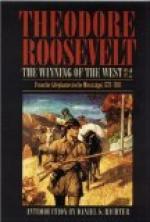No sooner had the preliminary treaty been agreed to in the spring of ’77 than the Indians again began their ravages. In fact, there never was any real peace. After each treaty the settlers would usually press forward into the Indian lands, and if they failed to do this the young braves were sure themselves to give offence by making forays against the whites. On this occasion the first truce or treaty was promptly broken by the red men. The young warriors refused to be bound by the promises of the chiefs and headmen, and they continued their raids for scalps, horses, and plunder. Within a week of the departure of the Indian delegates from the treaty ground in April, twelve whites were murdered and many horses stolen. Robertson, with nine men, followed one of these marauding parties, killed one Indian, and retook ten horses; on his return he was attacked by a large band of Creeks and Cherokees, and two of his men were wounded; but he kept hold of the recaptured horses and brought them safely in. [Footnote: Chas. Robertson to Captain-General of North Carolina, April 27, 1777.] On the other hand, a white scoundrel killed an Indian on the treaty ground, in July, the month in which the treaties were finally completed in due form. By act of the Legislature the Holston militia were kept under arms throughout most of the year, companies of rangers, under Sevier’s command, scouring the woods and canebrakes, and causing such loss to the small Indian war parties that they finally almost ceased their forays. Bands of these Holston rangers likewise crossed the mountains by Boon’s trail, and went to the relief of Boonsborough and St. Asaphs, in Kentucky, then much harassed by the northwestern warriors. [Footnote: See ante Chap. I.] Though they did little or no fighting, and stayed but a few days, they yet by their presence brought welcome relief to the hard-pressed Kentuckians. [Footnote: Monette (followed by Ramsey and others) hopelessly confuses these small relief expeditions; he portrays Logan as a messenger from Boon’s Station, is in error as to the siege of the latter, etc.] Kentucky during her earliest and most trying years received comparatively little help from sorely beset Virginia; but the backwoodsmen of the upper Tennessee valley—on both sides of the boundary—did her real and lasting service.




